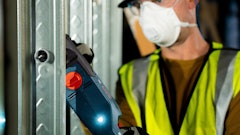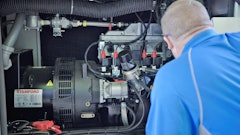
The rise of lithium-ion batteries has transformed the world of power equipment. These clean, quiet, and efficient alternatives to gas-powered tools have become a popular choice for homeowners and professionals alike. Battery-powered equipment is ideally suited for concrete work because of its rugged design, innovative safety features, reliable power, and ability to withstand dusty, harsh working environments.  Offering reliable runtime and smooth, swappable power, the new Vanguard 48V 1.5kWh swappable battery pack (Si1.5) is powering a variety of concept applications including a concept EDCO single head concrete grinder.Briggs & Stratton | EDCO
Offering reliable runtime and smooth, swappable power, the new Vanguard 48V 1.5kWh swappable battery pack (Si1.5) is powering a variety of concept applications including a concept EDCO single head concrete grinder.Briggs & Stratton | EDCO
Like their gas-powered counterparts, battery-powered machines thrive when they are well cared for. Here's how to ensure that your lithium-ion powered equipment delivers optimal power and a long lifespan, maximizing its environmental and performance benefits for years to come.
Charging Best Practices
One of the most important aspects of lithium-ion battery care is charging. These batteries are sensitive to charge cycles, and improper charging can have a detrimental effect on their overall lifespan. Always use the charger provided by the manufacturer. These chargers are designed to meet the specific needs of your battery and prevent overcharging—a common culprit in battery degradation. Most modern chargers are designed to stop charging once the battery is full, but it's a good practice to unplug the charger when the charging process is complete. This simple step can go a long way toward preserving the battery's health.
It's also important to note that lithium-ion batteries can be charged at any time, regardless of their charge level. Unlike other battery technologies, there is no need to fully discharge them before recharging. This flexibility allows more convenient use and helps maintain battery health.
Pro Tip:
Look for a piece of equipment powered by a battery that is made with its own charging platform. This usually means there are special safeguards and features built-in to optimize charging and prevent the issues that can come with overcharging.
Storage Conditions Matter
Storage conditions also play a vital role in the longevity of lithium-ion batteries. Extreme temperatures can have a significant impact on their performance and lifespan. When it’s not in use, store your battery-powered equipment and its battery in a cool, dry place, avoiding direct sunlight and areas prone to significant temperature fluctuations. This can help prevent irreversible damage to the battery cells. Refer to your equipment manual for specific recommendations, but a general guideline is a consistent temperature range between -20° and +60° C for one month of storage and -20° to +25° C for long-term storage. During extended periods of non-use, consider storing the battery separately in a climate-controlled space, especially if your equipment is typically stored in a garage or shed that experiences significant temperature swings throughout the year.
Prevention Is Key
Just like with any piece of equipment, preventative maintenance is another crucial aspect of lithium-ion battery care. Periodically check your equipment and battery for any signs of damage, wear, or corrosion. Pay close attention to the battery contacts and terminals, gently cleaning them with a dry cloth to remove any dirt or debris that might hinder proper connection. Concrete worksites are especially likely to generate dust and debris, so this is especially important for battery-powered concrete equipment.  Providing rugged, reliable power, the new Vanguard 48V 1.5kWh swappable battery pack (Si1.5) is powering a variety of concept applications including a concept EDCO electric concrete saw. The Si1.5 battery is now in production and available for order.Briggs & Stratton | EDCO
Providing rugged, reliable power, the new Vanguard 48V 1.5kWh swappable battery pack (Si1.5) is powering a variety of concept applications including a concept EDCO electric concrete saw. The Si1.5 battery is now in production and available for order.Briggs & Stratton | EDCO
Early detection is key. If you notice any damage to the battery, such as cracks, swelling, or leaking fluids, stop using the equipment immediately and contact the manufacturer for further guidance or replacement. Depending on the frequency of use, it is recommended to perform inspections at least weekly for heavily used equipment and monthly for occasional use.
Avoiding Deep Discharges
Unlike other battery technologies, lithium-ion batteries perform better when they are not deeply discharged. To maximize battery health and extend its lifespan, avoid completely draining the battery before plugging it back in. Most manufacturers recommend recharging the battery when it reaches around 20-30% capacity for optimal performance. Deeply discharging a lithium-ion battery can cause it to lose capacity over time and reduce its ability to hold a charge. It's best to keep the battery within a moderate charge range, avoiding both full discharge and continuous overcharging.
Following the Manufacturer's Lead
The manufacturer's instructions are your best resource for ensuring the proper use and care of your equipment. Don't push your equipment beyond its recommended capabilities. Overloading or exceeding its intended workload can put undue stress on the battery and shorten its lifespan. Regularly clean the equipment and remove any debris that might have built up. This helps the machine operate more efficiently and places less strain on the battery.
Software Updates
In today's digital age, some battery-powered equipment comes equipped with smart features and firmware updates. Keep your equipment's software up to date to make sure it operates efficiently and to take advantage of any updates that may improve battery performance and overall functionality. Manufacturers often release updates that address potential issues, enhance battery management systems, and optimize power consumption.  Enhancing productivity, standardization, and cost-effectiveness, the Vanguard 48V 1.5kWh swappable battery pack (Si1.5) is powering a variety of concept applications including the concept MUCK-TRUCK E-MAX Wheelbarrow.Briggs & Stratton | Muck-Truck
Enhancing productivity, standardization, and cost-effectiveness, the Vanguard 48V 1.5kWh swappable battery pack (Si1.5) is powering a variety of concept applications including the concept MUCK-TRUCK E-MAX Wheelbarrow.Briggs & Stratton | Muck-Truck
Safety First
As with all construction equipment, safety should always be a top priority. Follow the safety guidelines provided by the manufacturer, and if you suspect any issues with the battery, stop using the equipment immediately. Store the equipment away from flammable materials and follow proper disposal procedures if the battery needs replacement. As an operator, always wear proper protective gear when handling batteries or operating electrified equipment. With concrete work, operators are often working in dusty conditions and indoors. Battery-powered equipment has significantly changed the working conditions for crews and operators when it comes to noise, vibration, and overall comfort and safety on the jobsite.
By following these practices, you can ensure that your lithium-ion-powered concrete equipment delivers optimal performance and a long lifespan, minimizing your environmental impact while you tackle the task at hand. Battery power not only enhances the operator experience when it comes to comfort and safety but also contributes to a more sustainable and efficient jobsite. Remember, a little care goes a long way in keeping the power and reliability of your equipment at peak performance.





















